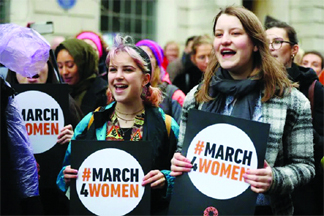
International Women’s Day (IWD), grew out of the labor movement to become a recognised annual event by the United Nations (UN). The seeds of it were planted in 1908, when 15,000 women marched through New York City demanding shorter working hours, better pay and the right to vote. A year later, the Socialist Party of America declared the first National Woman’s Day.
The idea to make the day international came from a woman called Clara Zetkin, communist activist and advocate for women’s rights. She suggested the idea in 1910 at an International Conference of Working Women in Copenhagen. There were 100 women there, from 17 countries, and they agreed on her suggestion unanimously.
It was first celebrated in 1911, in Austria, Denmark, Germany and Switzerland.
Things were made official in 1975 when the United Nations started celebrating the day. The first theme adopted by the UN (in 1996) was “Celebrating the Past, Planning for the Future”.
International Women’s Day has become a date to celebrate how far women have come in society, in politics and in economics, while the political roots of the day mean strikes and protests are organised to raise awareness of continued inequality.
RUSSIAN REVOLUTION: A TURNING POINT
Throughout the early 20th century, International Women’s Day became increasingly associated with the fight for women’s suffrage and labour rights. In 1917, Russian women observed a strike for ‘Bread and Peace’ on March 8th, which marked the beginning of the Russian Revolution.
The date coincided with International Women’s Day, and the strike played a significant role in the eventual overthrow of the Tsarist regime and the granting of women’s suffrage in Russia.
RECOGNITION BY THE UNITED NATIONS
Following these events, International Women’s Day continued to be celebrated annually, spreading to other countries and becoming a symbol of women’s solidarity and activism.
During the mid-20th century, the focus of International Women’s Day expanded to address a broader range of issues affecting women, including reproductive rights, workplace discrimination, and violence against women.
While much progress has been made since the inception of International Women’s Day, significant challenges remain. Gender inequality persists in many aspects of society, including access to education, healthcare, and economic opportunities.
Women continue to face discrimination and violence based on their gender, and their voices are often marginalised in decision-making processes.
RENEWING COMMITMENT TO EQUALITY
As we commemorate International Women’s Day each year, let us renew our commitment to building a more inclusive and equitable world, where every woman and girl has the opportunity to fulfil her potential and contribute to the betterment of society.
Together, we can strive towards a future where gender equality is not only a goal but a reality for all.
Why 8 March?
Clara’s idea for an International Women’s Day had no fixed date.
It wasn’t formalised until a war-time strike in 1917 when Russian women demanded “bread and peace” – and four days into the strike the Tsar was forced to abdicate and the provisional government granted women the right to vote. The date when the women’s strike commenced on the Julian calendar, which was then in use in Russia, was Sunday 23 February. This day in the Gregorian calendar was 8 March – and that’s when it’s celebrated today.
Purple, green and white are the colors of the day, according to the International Women’s Day website.
“Purple signifies justice and dignity. Green symbolizes hope. White represents purity, albeit a controversial concept. The colours originated from the Women’s Social and Political Union (WSPU) in the UK in 1908,” they say.
How is Women’s Day celebrated?
International Women’s Day is a national holiday in many countries, including Russia where flower sales double during the three or four days around 8 March.
In China, many women are given a half-day off work on 8 March, as advised by the State Council.
In Italy, International Women’s Day, or la Festa della Donna, is celebrated by the giving of mimosa blossoms. The origin of this tradition is unclear but it is believed to have started in Rome after World War Two. In the US, the month of March is Women’s History Month. A presidential proclamation issued every year honours the achievements of American women.
SIGNIFICANCE OF WOMEN’S DAY
International Women’s Day holds immense significance globally as a day dedicated to celebrating the social, economic, cultural, and political achievements of women. It serves as a reminder of the contributions women have made to society, often in the face of adversity and discrimination.
Moreover, Women’s Day highlights the persistent challenges women continue to face, including gender-based violence, unequal access to education and healthcare, and under-representation in leadership roles.
CHALLENGES AND OPPORTUNITIES
While Women’s Day is a time for celebration, it also serves as a reminder of the work that remains to be done. Gender inequality persists in various forms, including unequal pay, lack of access to education and healthcare, and gender-based violence.
Addressing these challenges requires concerted efforts from governments, civil society, and the private sector to enact policies and programs that promote gender equality and empower women and girls.
WHY DO WE NEED IT?
Gender inequality persists in areas like pay, education, healthcare, and violence. IWD raises awareness, celebrates women, and pushes for change toward equal opportunities and rights.
What Is The IWD 2024 Theme?
The theme of this year’s Women’s Day is ‘Invest in women: Accelerate progress’. This theme means that establishing gender equality and women’s well-being in all aspects of life is more important than ever in order to develop strong economies and a healthy world. When we value and respect women from all different backgrounds, the world gets better for everyone.
Here are key areas needing joint action:
Investing in women, a human rights issue
Time is running out. Gender equality is the greatest human rights challenge, benefiting everyone.
Ending poverty
Due to the COVID pandemic and conflicts, 75 million more people have fallen into severe poverty since 2020. Immediate action is crucial to prevent over 342 million women and girls living in poverty by 2030.
Gender-responsive financing
Conflicts and rising prices may lead 75% of countries to cut public spending by 2025, negatively impacting women and their essential services.
Shifting to a green economy
The current economic system disproportionately affects women. Advocates propose a shift to a green economy and care society to amplify women’s voices.
Supporting feminist change-makers
Despite leading efforts, feminist organizations receive only 0.13% of official development assistance.





Be the first to comment